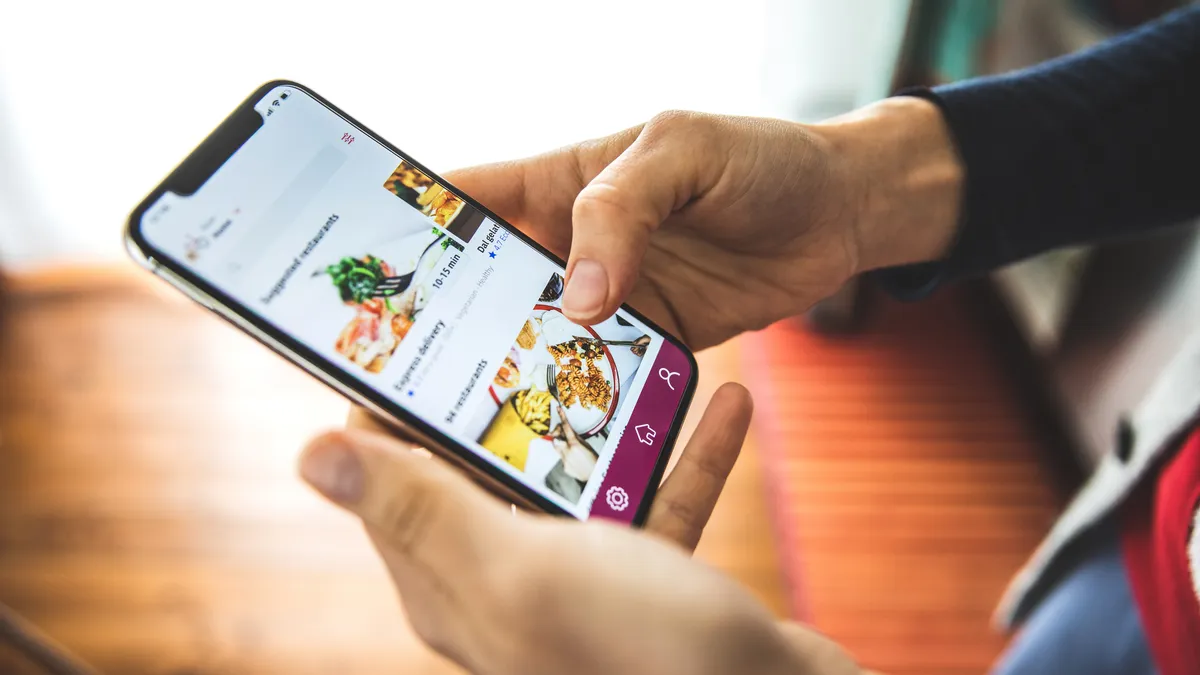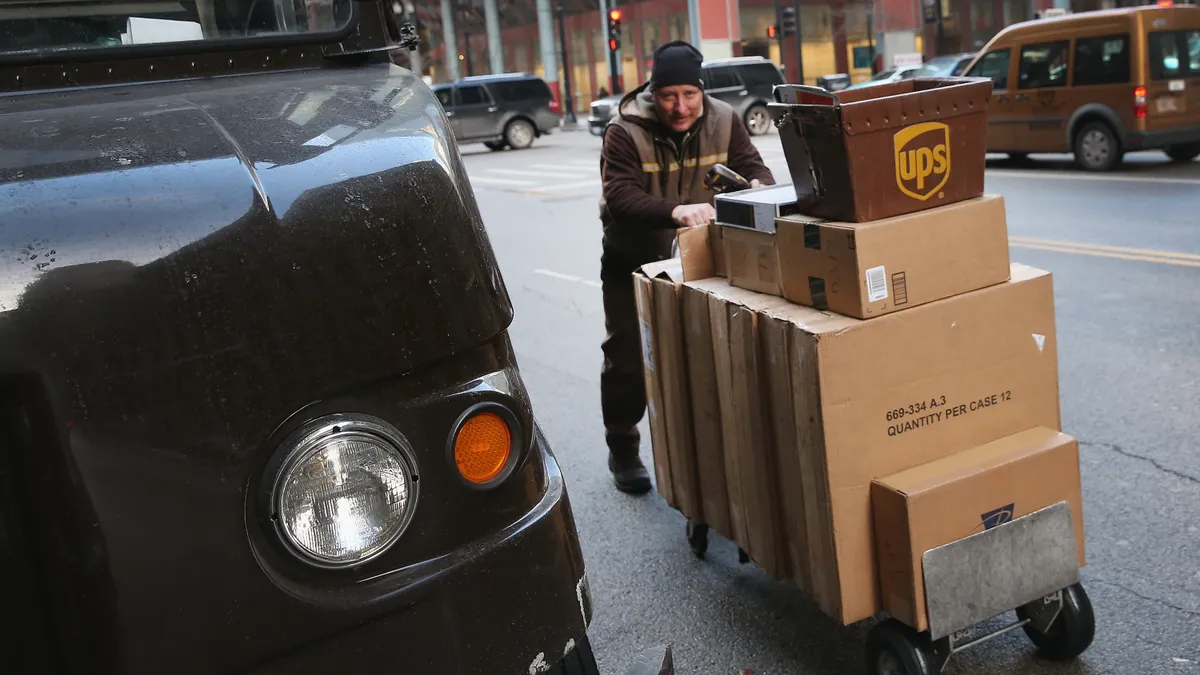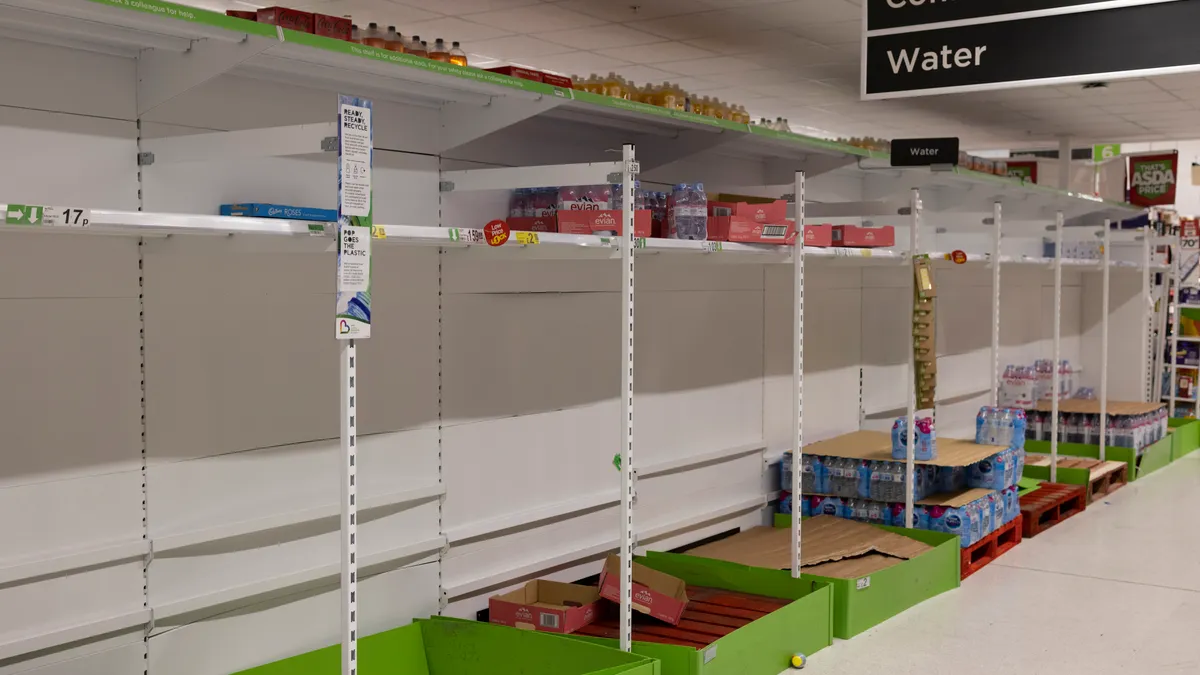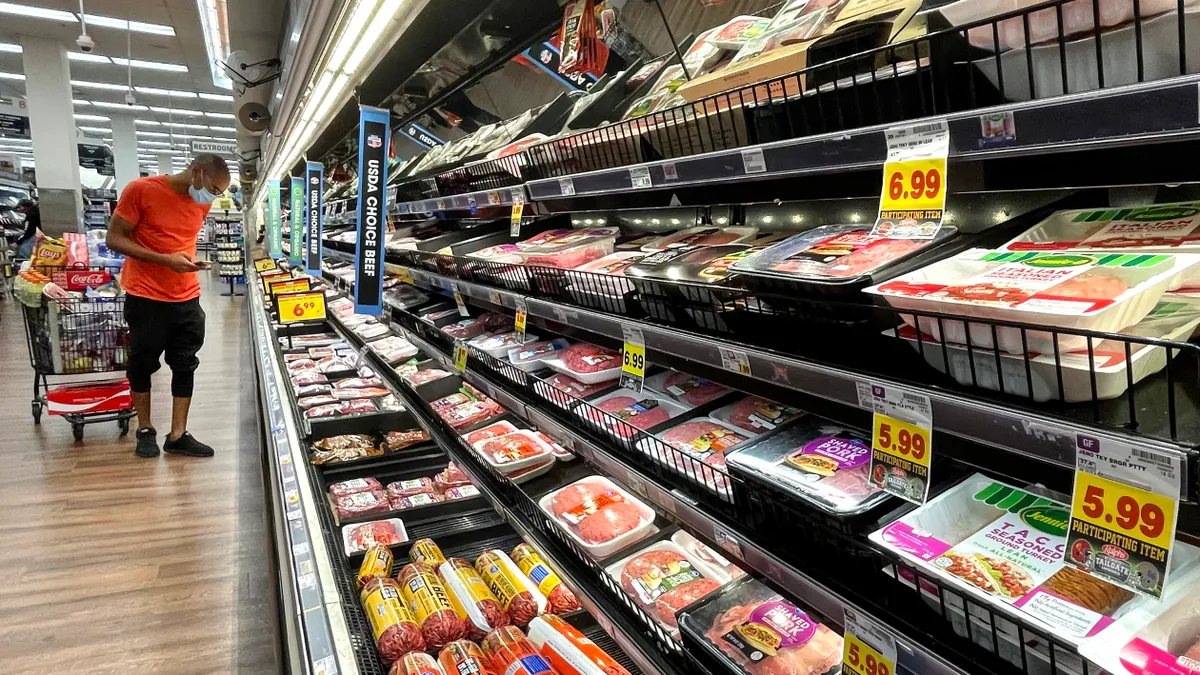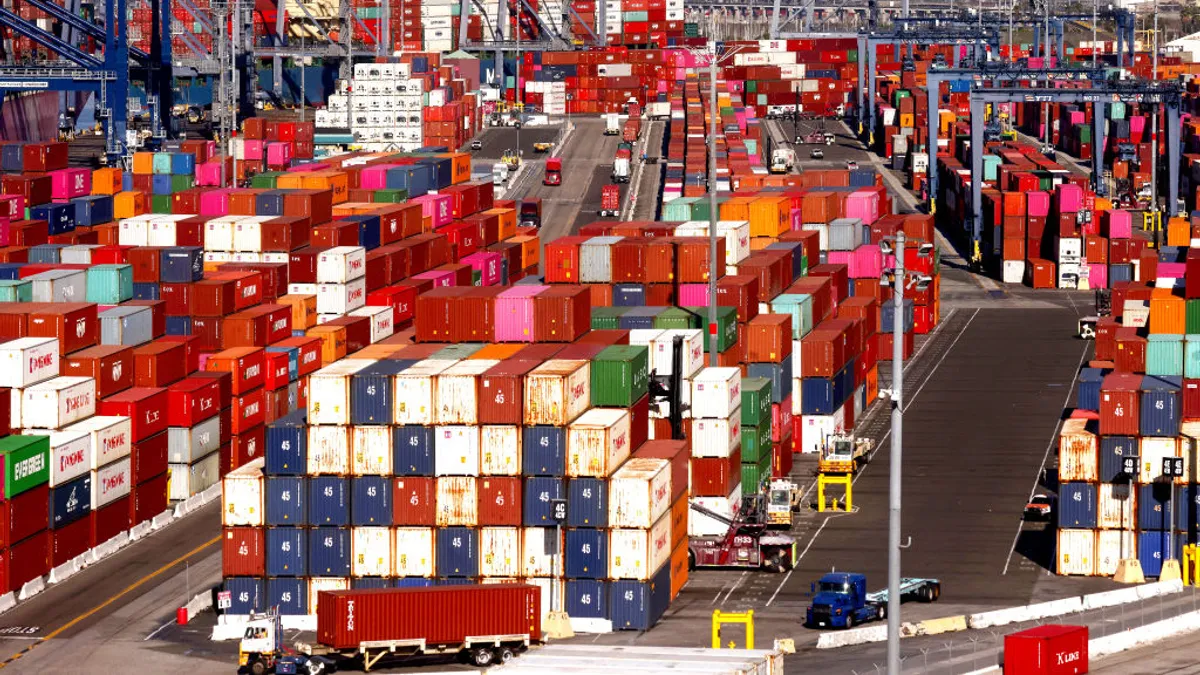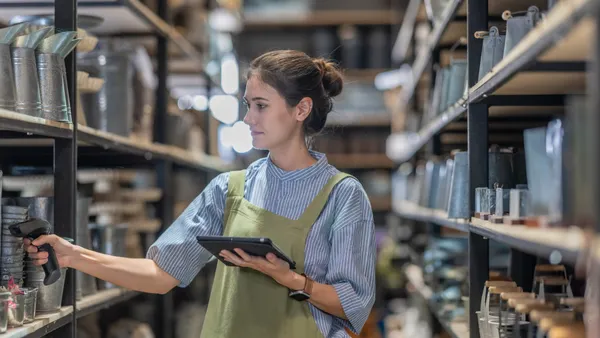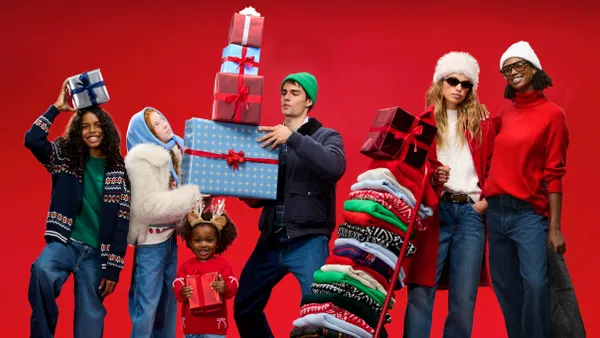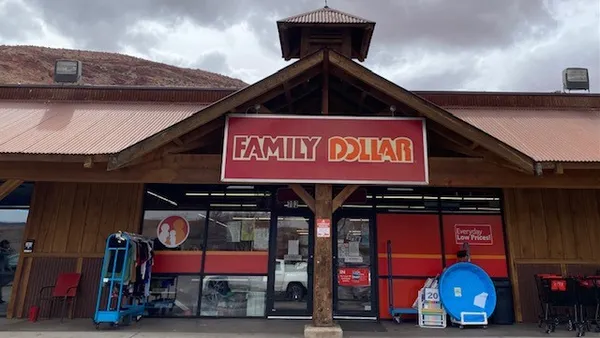Editor's note: This story is part of a series on the trends, opportunities and challenges supply chains will face in 2022. Read the full outlook here.
Over the past two years, third-party delivery aggregators made a feast of the pandemic environment that threatened so many restaurant operators with famine.
Delivery accounted for 8% of restaurant sales at the end of Q3 2021 — a ratio experts predicted would shake out in 2025, NPD Group senior vice president and industry advisor David Portalatin told Restaurant Dive. Five years before the COVID-19 crisis, that percentage hovered around 3%.
But this elevated growth, which analysts said was driven by an increase in repeat customers, isn't likely to last.
"I don't think you're going to see a restaurant industry that is ever 20% delivered," Portalatin said.
Sales had already started to slow down at DoorDash and Uber Eats in Q3 2021, Lyle Margolis, CFA and senior director at Fitch Ratings, told Restaurant Dive. DoorDash's financial guidance also suggests it is going to flatten this year, Margolis said.
"We're not going to see that kind of meteoric growth we saw over the next couple of quarters," Margolis said.
As the space continues to evolve, aggregators are working to deepen their relationships with restaurants and find ways to make delivery work for them. Since 2020, these companies have added white label online ordering for restaurants, offered more flexible pricing and implemented subscription programs to boost retention among restaurants and diners.
Restaurants weigh the cost of delivery
As diner traffic returns to pre-pandemic levels, some restaurants are starting to rethink their delivery capabilities, especially since the channel is often less profitable than dine-in and takeout. A handful of operators within Darden, Cheesecake Factory, Dine Brands and First Watch have begun shutting off delivery during high in-store traffic times, for example.
But from a data standpoint, Marty Hahnfeld, chief customer officer at Olo, told Restaurant Dive the company has never seen this decision made at the top level of a brand.
"What we've seen are individual locations that are maybe in a bind looking to slow the pace a little bit," Hahnfeld said. "We can count on a couple of hands the number of times that's happened that we're aware of across our 75,000 restaurant locations. I think it's a great headline. I don't think it's really a trend that’s reflective of anything."
Even if these incidents are rare, they are an example of how operators are trying to balance delivery costs with delivery gains, especially as diners continue to demand the offering.
"There's a lot of tension between independent restaurants and third-party [aggregators]. It's expensive and where's that cost coming from? I'm a big believer that ultimately when the consumer demands something in the marketplace, there will emerge a solution that is palatable to all parties," Portalatin said.
Delivery companies have extended various incentives, including direct cash and subsidized rates, for independent restaurants over the past two years. But the dark side of aggregators' track records, including lawsuits and complaints over practices like high commission rates, are still top of mind for restaurants, Raj Joshi, vice president and senior credit officer at Moody's, told Restaurant Dive.
Still, delivery can be very beneficial for certain types of restaurants, such as operators that don't have their own delivery channel or others that have excess capacity and aren't fully utilizing their kitchen resources, Joshi said. But many restaurants may not need third-party delivery in a post-pandemic world, he said.
A wave of new product and service offerings
While delivery orders increased during the pandemic and the channel remains popular, about 44% of consumers are more likely to order directly for delivery from a restaurant. Comparatively, 17% of diners order from aggregators, according to a PYMNTS and Paytronix Digital Divide report, which surveyed 2,213 U.S. consumers from Sept. 2 to Sept. 9.
Delivery aggregators have responded to this consumer behavior by offering tools and resources that help restaurants create online ordering capabilities.
In 2020, Uber Eats added tools that allow restaurants to offer online ordering directly from their websites for pickup or delivery. Uber Eats' manager platform also lets operators view customer analytics and orders in real time. The insights provide suggestions of how to boost customer retention or orders. If a location has a 15% retention rate, which is lower than average, the manager platform might suggest the operator test a loyalty program or reply to reviews, Yadavan Mahendraraj, Uber's head of merchant operations in the U.S. and Canada, told Restaurant Dive.
"We're not only giving them more data, but also [we're] giving them a better way to parse that data," Mahendraraj said.
Grubhub added its Grubhub Direct product in May, offering independent restaurants the ability to create customizable ordering websites, manage customer relationships and access diner data.
These online ordering capabilities also give restaurants the opportunity to access delivery customer data, which has been a longtime interest of Grubhub's restaurant partners, Theresa Dold, vice president of agency services and product at Grubhub, told Restaurant Dive.
DoorDash launched its turnkey, digital storefronts in 2020 as part of its Main Street Strong Initiative. DoorDash found that a large portion of small and midsize businesses didn't have access to online ordering on their websites, and saw an opportunity to create that tool, which helped expand its offering from a marketplace to a broader platform, Ryan Parietti, DoorDash's senior director of merchant strategy and operations, told Restaurant Dive.
"All types of restaurant technology providers are figuring out, if they're not already playing in this branded online ordering space, how to get there," Dold said.
In-house online ordering systems also allow restaurants to avoid the commission fees that come with being on a third-party delivery marketplace. Grubhub Direct, for example, charged a monthly hosting fee for the website of $49 and a one-time set up fee of $99 until October, before it removed the fees entirely. Restaurants aren't charged for marketing commission fees. DoorDash's Storefront offering is also commission-free, and Uber Eats charges 29 cents per order placed through restaurant websites supported by its Webshop feature."
"All types of restaurant technology providers are figuring out, if they're not already playing in this branded online ordering space, how to get there."

Theresa Dold
Vice president of agency services and product, Grubhub
"[Restaurants] are going to want a platform that allows them to run a specific promotion for their branded online ordering site that might be distinct from what they’re running on [the] marketplace because of the profit margins they are trying to maintain," Dold said.
Grubhub Direct is also part of the company's long-term strategy to become a one-stop shop for restaurant partners.
"As a restaurant has evolving needs in terms of how they want to grow their digital business online, we believe we can plan an even more fundamental role in that journey outside of being just a marketplace for our restaurant partners," Dold said.
Delivery companies have also implemented different pricing structures to allow restaurants to pick and choose the kinds of services and fees that best suit their business plans. They have also been offering restaurants that do self-delivery ways to outsource the actual delivery fulfillment to aggregators in order to expand their reach and capabilities.
DoorDash launched its merchant pricing plans in April to provide more flexibility in different models, while Uber Eats did so in September. Both now offer tiered pricing depending on the types of services restaurants require.
"What I think you'll see most of all [is] it's not one-size fits all. I think you'll see all the platforms evolve to really give merchants that flexibility to make whatever choice they need that works for them," Mahendraraj said.
Both Grubhub and DoorDash also added self-delivery products in 2021, allowing restaurants to use third-party couriers alongside in-house delivery to complete orders and help expand their delivery reach.
"[Grubhub has] invested quite a bit in a product offering that will allow those restaurants to expand their delivery radius," Dold said. "That is something that I think will be really, really fundamental to Grubhub's growth and the success of our restaurant partners."
DoorDash also launched a nationwide shipping program last fall to allow customers to order items from local merchants across the country.
"We're really excited about that type of feature that really shows the deeper partnership … that we can build over time," Parietti said.
Retaining customers with subscriptions
While aggregators have expanded their products and services for restaurants, they have also boosted diner loyalty through subscription or membership services for a set monthly price, which is helping with customer retention and order volume.
"[Third-party aggregators] are going to become subscription services to some extent where it's going to make it that much easier for people to get delivery because they've already prepaid, which is going to help bring down some … costs," Matthew Goodman, senior equity research analyst at M Science, told Restaurant Dive.
Grubhub's subscription program, Grubhub+, has grown to 2.5 million members since its launch in 2020, and these subscribers now account for about 30% of its current orders, Adam DeWitt, Grubhub CEO, said in October during Just Eat Takeaway's Capital Markets Day.
"Because of our better supply, and … subscription loyalty program, diners are sticking around longer and ordering more," DeWitt said. "Our new diners are 20% to 30% more productive than [customers acquired in] 2019."
During Q3, DoorDash increased its DashPass membership to 9 million. M Science's data shows that about 25% of all DoorDash users at that time were DashPass subscribers.
In Q3, DashPass subscribers spent $650 to $800 per quarter on average compared to non-DashPass users who spent $200 to $300 per quarter, Goodman said.
Uber Eats members increased their trips per month by over 50%, Uber CEO Dara Khosrowshahi said during the company's Q3 2021 earnings call in November. Basket size for members was 10% higher than for non-members, he said.
In November, Uber also launched a membership program called Uber One that bundles its rides, grocery and food delivery services for a cost of $9.99 per month or $99.99 per year, and includes 5% off eligible rides and delivery orders, among other incentives.
"I think the more categories you expand to, the more perks and benefits you can layer into a program like that, the broader the appeal," Tom White, senior research analyst at D.A. Davidson & Co., told Restaurant Dive. "Just as Amazon over time added more value over time to its Prime membership beyond just free delivery, the industry will see companies like Uber continue to expand into new categories to enrich their membership offerings," White said.
Deepening restaurant relationships
Delivery aggregators have expanded their account management and sales teams as well to improve their relationships with operators and so they can better provide actionable data to their partners. Grubhub has been aggressively expanding its sales staff to bring on more restaurants in its stronghold cities and surrounding suburbs, and in some areas it has tripled its resources, DeWitt said.
"We want to be a one-stop-shop for all our restaurant partners' needs," Dold said. "As a restaurant has evolving needs, in terms of how they want to grow their digital business online, we believe we can play an even more fundamental role in that journey outside of [Grubhub] being just a marketplace for our restaurant partners."
DoorDash rolled out its Merchant Experience Partner program to provide better account management of its partners. Operators can reach out with questions related to menu updates, account settings and banking and reconciliation issues, for example.
DoorDash's Restaurant Advisory Council, which is effectively a group of restaurants and small business owners from the U.S. and Canada, also advise the company on key initiatives and give ground-up feedback on what restaurants need, Parietti said. DoorDash also brought on Chef Stephanie Izard as its chief restaurant advisor last May to bring another voice of the industry to DoorDash.
"I think keeping a tight feedback loop with our merchant partners allowed us to understand what the need was and then move really quickly into action," Parietti said, adding that its newest programs were piloted with a small group of merchants to make sure they were fully supported before they were launched on a full scale.
Uber Eats has hired hundreds of sales staff and account managers in local markets. By making staff that also live in these local communities more available to Uber Eats partners, the provider has been able to have longer and broader conversations with its merchants.
"I think keeping a tight feedback loop with our merchant partners allowed us to understand what the need was and then move really quickly into action."

Ryan Parietti
Senior director of merchant strategy and operations, DoorDash
Uber Eats has more than tripled its workforce of account managers working directly with its partners, which gives them more time to learn about the partner's business, including what their goals are, how it can work with these partners and how they can help these partners achieve their goals, Mahendraraj said. That could mean helping them figure out what pricing structure works best for the partner or offering free credits on advertising that can help get the brand off the ground, for example.
"We've had almost a hundred conversations at this point with different merchants across our platform with our products teams and with our internal teams to just get a good sense of what is working, what is not. And as we look toward what we're going to build in 2022, you'll see that a lot of that comes from the asks they have made," Mahendraraj said.
These internal aggregator reviews, and subsequent product and service launches, bode well for the restaurant-delivery relationship, especially since analysts predict off-premise demand will hold steady.
"It's hard to imagine that there are any restaurants coming out of the pandemic that don't view online ordering and delivery as really a mission critical thing that they have to get right," White said.
Correction: In a previous version of this article, a description of Grubhub Direct's fees was incorrect. Since October, Grubhub no longer charges monthly hosting fees or one-time set up fees for the ordering service. The article has also been updated with additional information about what DoorDash and Uber Eats charge restaurants for their direct ordering solutions.



